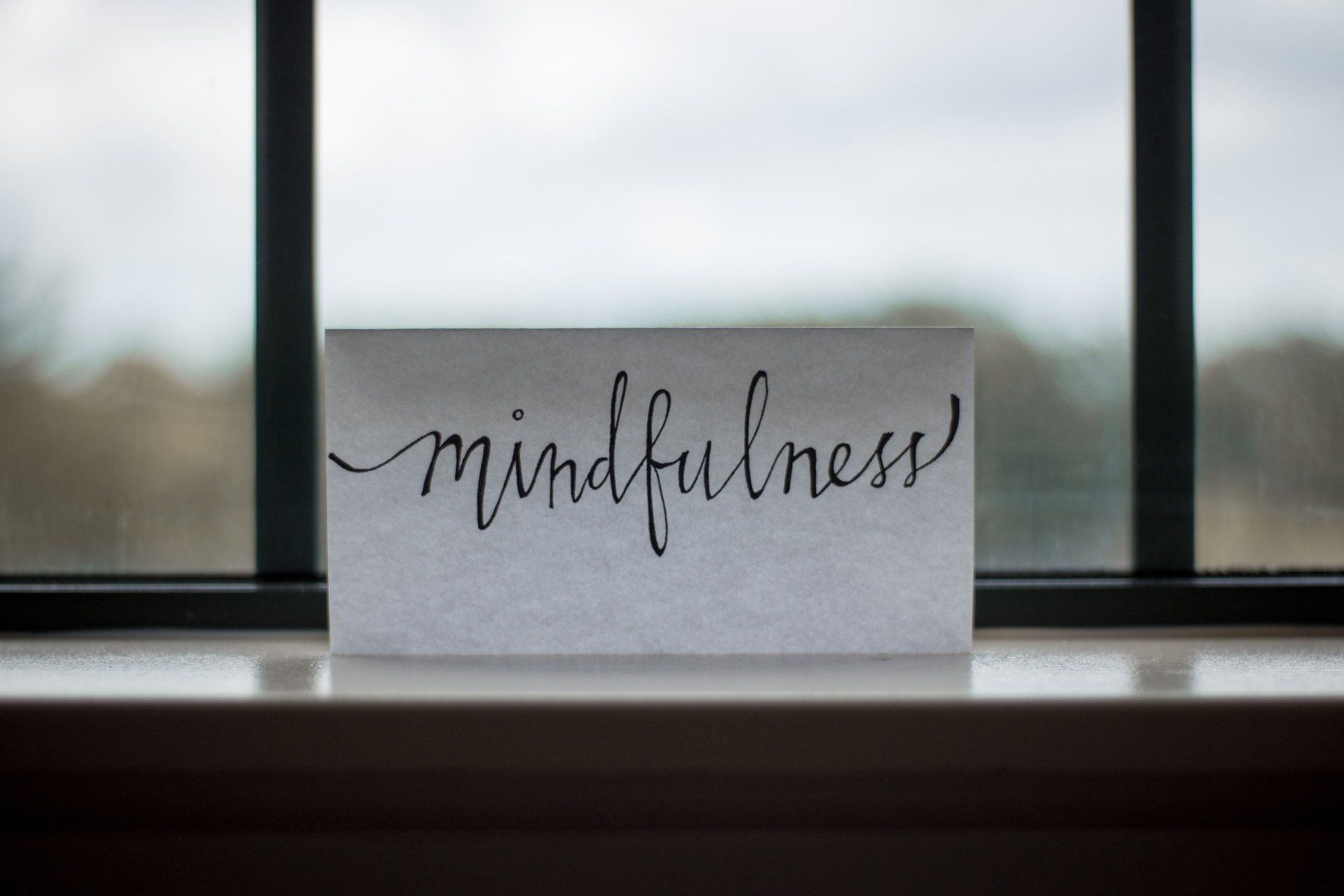"Trauma is not what happens to you. Trauma is what happens inside you as a result of what happened to you"-Gabor Mate

Mindfulness encompasses a variety of definitions although most are similar in concepts. Mindfulness is described as an awareness that arises from purposely paying attention in the present free from any judgements. Mindfulness is a state of awareness of ones emotions, thoughts, and sensations when each occurs. A third definition of mindfulness is a nonjudgmental state of awareness of present experiences. Various interpretations exist dependent on the context in which mindfulness is being examined. For example, mindfulness can be examined in improving emotional regulation and as a coping tool for stress management. Mindfulness is being in the present moment in ones body in a fully conscious state, aware of ones own experiences without judgement or narrative- just being in the moment in the here and now with an acceptance of how things are; being aware of our own thoughts, emotions, sensations without being caught up in them- an outside observer of self with an awareness of the moment. Mindfulness can be used throughout the day when walking, eating, and whenever feeling emotionally “charged” to step back and observe internal experiences. Yoga, meditation, and breathing are a few ways to cultivate mindfulness. Being mindful allows for intentional actions and responses rather than living on autopilot without being aware. The benefits of mindfulness are plentiful, and a regular practice is beneficial for enhancing wellness. Being able to stop and really get into the here and now and out of automatic unconscious living enhances feelings of well-being and an ability to respond more effectively with emotional control. Mindfulness can improve experiences and interpersonal relationships alike. Mindfulness is Intentional Living. Give it a try and see what happens. How do you define mindfulness? How do you cultivate mindfulness in your daily life?

Each day in the United States, an average of 3.1 million COVID-19 vaccines are going into people’s arms. According to an April 9 White House briefing, a quarter of the country's adults are now fully vaccinated. The pandemic is not yet over, but vaccination could soon yield a much more normal life, especially for those who have been vaccinated. The Centers for Disease Control and Prevention, for example, now recommends that fully-vaccinated people can visit with each other indoors and travel without quarantining. But for many, reopening comes with its own set of anxieties. According to APA's Stress in America polling, around half of people say they feel uneasy about readjusting to in-person interaction post-pandemic. Ellen Hendriksen, PhD, a clinical psychologist at Boston University's Center for Anxiety and Related Disorders and author of How to Be Yourself: Quiet Your Inner Critic and Rise Above Social Anxiety , is an expert at clinical strategies for calming anxiety. She spoke to APA about what's driving post-pandemic anxiety and how psychologists can best help. What do you think is driving the anxiety many people are feeling about reopening? Anxiety is driven by uncertainty. There is so much uncertainty right now, from the vaccine roll-out to society reopening to the new normal workplace to the virus and the variants themselves. Every day there is more evidence that vaccines keep us and people around us safe, but there are lingering questions about how long immunity lasts, how susceptible kids are to COVID-19, and when they will get vaccinated. Nobody alive today has ever emerged from a global pandemic into a digital world and navigated this before. We're making it up as we go along, so of course we're anxious. Here at the Center, we have the longest waitlist in our 25-year history. So many people are emerging from the pandemic feeling exhausted, burned out, anxious, or depressed. Collectively, our resources are low, which makes it harder to navigate the layers of uncertainty. How can people handle social anxiety and awkwardness around different levels of comfort as places reopen? The fact that reopening is a moving target makes it difficult to align with other people. You and your bubble might be ready to dine in at a restaurant or get on a plane, but the family next door might have a child who is immunocompromised and is living as they were in January. There are more variables to manage compared with before the pandemic. Plus, social anxiety is driven by avoidance, and we've all been avoiding social interactions for the better part of a year. The fact that we're all rusty is going to make us feel wobbly as we re-enter. It's OK to say we don't know how to do this, and it's OK to ask people what they're comfortable with. That normalizes the uncertainty and awkwardness, and it's quite validating to say, “What are we doing?” or “How does this work?” It can help you feel like you are united with the other person against this larger problem, as opposed to negotiating one against the other. This is a strategy borrowed from couples therapy, where it is often highly effective. How can people feel more comfortable with re-entry? There's one question I've been getting over and over from people who struggle with social anxiety. They'll say, "I did so much work pre-pandemic to get to the point where I could give a presentation or raise my hand in class." They’re worried they’ll be back at square one when they are again in large groups. But social confidence is like a muscle. If you have done work on your social anxiety in the past, that architecture is still there. It will feel awkward at first, but it will come back faster than the first time around. As for feeling comfortable returning to everyday activities, there are dozens of points of re-entry. There will be a first time on public transportation, a first time in someone's house, a first time taking a rideshare. We'll work our way up to large gatherings. Just because you feel rusty or nervous doesn't mean you're doing it wrong. It means you're getting back out there. Your brain will recalibrate with experience. We all need love, support, and community. Studies show that the quality of our relationships predict our future health, happiness, and even longevity, so it's worth it to push ourselves a little to get the interaction we all need, even if we are the most introverted of introverts. What should psychologists keep in mind for helping their clients right now? Psychologists have a big job ahead of us. It may be hard to balance supporting and pushing our clients simultaneously. It’s important to support each individual’s comfort level and choices, but psychologists also need to notice and address life-limiting avoidance. These are anxious, uncertain times, but there is also a sense of hope and renewal. It is an honor that we as psychologists get to play a leading role. Article by Stephanie Pappas from the American Psychological Association (APA)

Imagine you are sitting in a car, and you are driving down a lonely highway. Suddenly, in the middle of nowhere, a warning light goes off. Your oil pressure is very low. If you just ignore it and continue your drive, you run the risk of doing serious damage to your engine. You know you can get a tow, but this is going to take a while. As you are considering your next step, you suddenly remember a trick about how you can short circuit the warning light. This would not change anything about the engine—it would still be starved for oil—but the low-pressure signal would no longer be blinking on your dashboard, and you could ignore it more easily. Here’s the question: Should you do it? Unless you are seriously intoxicated (at which point you shouldn’t be driving at all), you won’t hesitate to say “no” to that impulse. Rightly so. Turning off the light will not do anything for you. The light is just the messenger, and not the problem in itself. Instead, you would be better advised to take in the information and deal with the situation. This is easy and intuitive to understand when it comes to external problems like car maintenance. It’s much more confusing, however, when the problems occur internally. When we are confronted with difficult emotions like anxiety, depression, stress, grief, anger, or loneliness, we are quick to search for the off-button on our emotional dashboard instead of taking in the messages they contain. Make it stop! Give me the wine and cigarettes. Let me cancel this appointment. Engage me on social media. Show me the movies and video games. Do whatever, but just make it stop! This is often our first response when difficult emotions show up: We try to mute the signal. But emotions are not the problem. They are merely messengers. And the messages they carry deserve at least to be heard. They often contain important lessons, and can call us to helpful actions. Often they show us opportunities. What Emotions Can Signal Fear might show us that danger is up ahead, and we better prepare ourselves. Loneliness might urge us to prioritize close relationships. Grief might open us up to what is important and meaningful to us, while calling out for social connection and support. Your dashboard doesn’t need to be covered up. It needs gentle attention. No, the dashboard isn’t everything—you still have a road to see and navigate. When emotions arise, you can ask yourself: “What am I feeling right now?” and “Where can I feel it?” and “What does my emotion ask me to do?” and “What does this suggest I am yearning for?” No one turns their driving over to a dashboard, but questions like these help our emotions play their proper role. If it were just negative emotions, this “turn off the indicator” move would be bad enough, but we are similarly incompetent when it comes to positive emotions. Imagine noticing on your car’s dashboard that your fuel tank is full. Oh, joy! You want it to stay this way, and so you decide to rewire so that the gauge always remains full. And people avoid positive emotions too! When we feel joy, we sometimes focus on how we will feel when it goes away, so we try never opening up to joy at all. That would be like the person who just disconnects the fuel gauge altogether so that she will never be disappointed when the fuel runs out because she never allowed herself to notice it was full in the first place. All of this is self-defeating, and yet it’s exactly what many of us do when we feel happy or sad or anxious or hopeful or depressed or satisfied. We like feeling this way, and never want it to stop, and so we cling onto this pleasant feeling, in the hopes of never losing it. Or we detune so it won’t be noticed when it stops, as if being numb is the definition of happiness. We dislike feeling this way, so we push it away as if feelings are the enemy. Feelings are not just about like and dislike. They are how our past and present impact us. They help train our ability to notice what is present, based on what we’ve experienced in the past. They’re like dashboard gauges that help us adjust to the challenges of our life journey. Emotions are temporary. They aren’t meant to be avoided, nor are they meant to be clung to. They are meant to come and go, flowing through you in their own time. They contain important lessons when things are off, and beautiful rewards when things fall into place. Allowing emotions to be there when they occur, to listen closely to their message, to feel them fully with neither clinging nor needless defense, allows them to serve their proper role. Your emotions are not the problem, so feel fully, embrace the change, move forward, and learn how to drive. For more on the Author: Steven C. Hayes, Ph.D.

We’re more than one year into the global pandemic that has kept many Americans sequestered in their homes and taking precautions to prevent the spread of COVID-19 when they go out. Not surprisingly, these changes in how and when we interact with others has led to changes in our mental and physical health. Among those changes, emerging data show that many Americans have gained weight, are drinking more alcohol, and are not sleeping well. A nationally-representative survey of 1,500 Americans conducted this year by the American Psychological Association found that more than 40 percent of Americans gained “more weight than they intended” during the pandemic. The average weight gain was 29 pounds, with 10 percent of participants reporting more than 50 pounds of weight gain. In addition, 18 percent of Americans reported losing more weight than they wanted to; the average amount of weight lost among this cohort was 26 pounds. In addition to weight changes, more than two-thirds of adults reported sleeping more or less than they wanted to. Nearly a quarter reported drinking more alcohol to cope with the stress of the pandemic. And more than 30 percent reported increased mental health issues since the start of the pandemic. Parents, essential workers, and minorities have fared worse The survey also collected information on specific groups of Americans; for example, parents. The data show that parents experienced more mental and physical health problems than others. Nearly half of mothers reported a decline in their mental health since the start of the pandemic, compared to 30 percent of all adults. Nearly half of fathers reported drinking more during the pandemic. Compared to the general population, parents were significantly more likely to have received treatment from a mental health professional and to have been diagnosed with a mental health disorder since the pandemic began. The pandemic has also taken a heavy toll on essential workers. More than half report relying on “unhealthy habits” to cope with pandemic stress. Such workers were more than twice as likely as adults who are not essential workers to have been diagnosed with a mental health disorder since the coronavirus pandemic emerged. Finally, racial minorities were more likely than others to report health declines during the pandemic. Both Black and Hispanic adults were more likely to report trouble sleeping and weight gain than white adults. In addition, Black participants expressed more concern about the future and more anxiety about re-adjusting to in-person interactions. A separate study published in the fall underscores the increase in alcohol consumption among Americans. Researchers surveyed a nationally representative sample of 6,000 Americans to find out how often participants drank alcohol and how much they drank. Researchers found that participants had increased the number of days they consumed alcohol by 14 percent during the pandemic. In addition, women reported a 41 percent increase in heavy drinking — four or more drinks in a short time period — and significantly more adverse consequences related to alcohol consumption. The take-home message: The global pandemic has taken a significant toll on Americans’ physical and mental health beyond illness related to COVID-19. About the Author: The Bronfenbrenner Center for Translational Research (BCTR) at Cornell University is focused on using research findings to improve health and well-being of people at all stages of life. Visit Cornell University’s Bronfenbrenner Center for Translational Research’s website for more information on our work solving human problems.

The idea of self-care gets a lot of attention, particularly in fields like health care and human services. Unfortunately, in spite of all the talk, many people still struggle to understand what it means and how to get enough of it. In this post, I’ll share four rules to make sure you are on track to living a self-caring life. Rule #1: Self-care includes self-talk. Many people protest when they hear about the idea of self-care because they believe they don’t have time to take a yoga class, don’t have money for a massage, or don’t have the energy to exercise. Although this all may be true, it misses the essential point that self-care is ultimately not about what you might do for an hour or two each week. Self-care is a way you live your life, and this includes how you relate to yourself each and every moment of the day. Self-talk does a lot to shape our mood, our stress levels, and whether we feel overwhelmed or in control. A busy day could be experienced as anxiety-provoking and burnout-producing, but it could also be seen as a challenge to rise and engage our many strengths in the world. The choice is yours. We do ourselves a disservice by overlooking this critical component of self-care. In fact, no self-caring behaviors will be effective if you are in the habit of stressing yourself out over and over again in your own mind. You may get a massage, but you’ll be thinking about work the whole time. You may take a yoga class, but you’ll be too busy comparing yourself to others in the room. So pay attention, and start chipping away at your own unique habits of unhelpful thinking; it is the most important and self-caring thing you can do. Rule #2: Distraction can be helpful, but only for a while. When I ask people what they do for self-care, most often they talk about ways they distract themselves from their stressors. Some common examples might be binge-watching television, reading a book, or going to a movie. There is nothing wrong with any of these activities on occasion. When emotions are running high or you are completely exhausted, the effort it might take to engage in more active pursuits or attempt to emotionally process what you are going through may prove to be too much. At such times, using distraction for self-care can be helpful. Problems can arise if the only self-care activities you engage in are things that allow you to check out, numb out, avoid, distract, or ignore your stressors. If this goes on for too long, you may find that you have a backlog of unprocessed thoughts and feelings that could cause your stress or burnout to worsen instead of improve. Rule #3: Find ways to emotionally process your experiences. To balance out your favorite distractions, look for activities that help you process the experiences of your life. Self-care needs to involve time to think your way through your stressors and to feel the emotions that come with them. For instance, if you are overwhelmed by several deadlines happening at once, no amount of distraction will help you in the long run. Instead, it may be better to engage in an activity that directly addresses your intense stress such as a guided relaxation exercise or a conversation with a colleague. Self-care means paying attention to your emotions and giving care and attention to them. The specific activities that help with emotional processing will vary between individuals but could include journaling, drawing, talking about your stress to a friend or therapist, prayer or spiritual practice, dancing, exercise, listening to music, or having a good cry. You might engage in reading or even watching television, but instead of distraction, you can seek out content that will address the challenges you are facing. For instance, you might read poetry that touches on the emotions you are working through, or watch inspirational speakers online instead of a distracting romance or crime drama. When considering self-care activities to fit this category, the most important question to ask yourself is: “Have I accessed my own thoughts and feelings, and do I have a somewhat better perspective, a sense of relief, or emotional release, after doing this activity?” If the answer is yes, then you’ve found something great. Rule #4: Take care of your physical health. In the pursuit of self-care, people often think they need to add something new and dramatic to their lives. It can be easy to waste time and money getting massages, signing up for meditation classes, and trying new hobbies hoping to find something that excites us. While all of these things can be part of self-care, don't overlook the simple daily routines that help maintain your physical health. Since you need to eat, sleep, bathe, and dress routinely anyway, these can be good places to improve your self-care habits. What if you chose food that really nourished you? What if you changed your bedtime, or finally bought that new pillow, to help you sleep better? All of these little things can turn your daily routines into opportunities for self-care. Engaging in self-care is a way of signaling to ourselves that we matter in our own lives. You do not need a lot of time, money, or exotic new activities to improve your self-care. By starting with your self-talk, taking care of your health, and achieving a better balance of distraction and emotional processing, you will be well on your way to living a truly self-caring life. For more on the author Katherine King Psy.D. click here

We all have an inner voice that comments on what we are doing, for better or for worse. Psychologists refer to this inner dialogue as self-talk. You are always going to engage in self-talk, but it doesn’t have to be negative. You can learn to notice it and reprogram it so that it is not negative but rather supportive of the changes in your life that you’re trying to make. Negative self-talk is very common. Most of our self-talk consists of beliefs programmed into us when we were children. We heard these beliefs so often, or in such emotionally intense situations, that now we believe them and repeat them to ourselves whenever the occasion arises. But do you really want major decisions about your life made by a 4-year-old or an 8-year-old? That’s what’s happening when we accept negative self-talk as the truth about us and about life. Some of our basic attitudes towards ourselves are rooted in unexamined childhood programming. Self-talk tells us what to do and how to feel about events and situations. A lot of self-talk feeds us valuable information that serves us well, that helps us succeed and even ensures our survival. For example, “Look both ways before crossing the street” and “Stand up for yourself” are constructive reminders. But other self-talk undermines us and keeps us from fully experiencing parts of our personality. Your inner voice may be telling you things like this: I know it won’t work. It’s just no use. I never have enough time. I never know what to say. Everything I touch turns to bleep. I wince whenever I hear an adult tell a child something like, “You’re stupid,” or “Academics are just not your strength.” If you want a person to act stupidly, both as a child and as an adult, telling them they’re stupid is a reliable way to program them to do so. Working on your self-talk is a good way to challenge the idea that there’s some inherent flaw in your personality. If you have deficits, you are not doomed to live with them forever; you can change your programming. When that changes, you may find you have hidden strengths where previously you had problems. Start paying attention to your self-talk. Write down some of the attitudes expressed during self-talk. Ask yourself, would I say to a friend the things I say to myself? Probably not. As adults, we know that saying negative things is hurtful and destroys friendships. So why do we say such things to ourselves? Self-Talk and Conflict Resolution Many of us repeat self-talk phrases that oppose our efforts at conflict resolution. For example, here are some self-talk phrases about conflict that many people accept without thought: Whenever anybody says anything bad about me, I must correct them by pointing out their personal flaws. The best defense is a good offense. There are winners and losers—and I’m going to be a winner. People who disagree with me are opponents to be overcome. Once I’ve picked the best option, I need to hang on to it and defend it. These phrases all describe a win/lose model of conflict resolution, and they all make it harder to reach a mutually acceptable solution to the conflict. If you approach conflict with these attitudes, your relationship will be the loser. Moving to Positive Self-Talk So how do we change negative self-talk? Using the computer programming analogy, we need to overwrite the negative programs and replace them with a new program. It sounds easy, but it is hard work. Here are the basic steps in reprogramming your negative self-talk to positive self-talk: 1. Watch for the self-talk statements about yourself. The first step is to pay attention to your self-talk and identify anything that is negative. You won’t be able to change your negative self-talk without noticing it. Some people find it helpful to keep a self-talk log. Carry a small notebook, and every time you notice negative self-talk, write it in the log. 2. Monitor the self-talk of people around you. Sometimes it is easier to see the impact of negative self-talk by noticing its effect on other people. Obviously, you won’t be able to listen in on their inner self-talk, but people often speak their self-talk out loud: ‘I’m just not good at those sorts of things,” “I haven’t got time to deal with that,” “I’ve always wanted to do that, but I just don’t have what it takes.” How does their self-talk limit them? Do they stop doing things they should or want to do? Do they avoid new behaviors that might be helpful or just plain fun? 3. Identify negative self-talk that you want to change. Next, identify those areas you want to work on. A lot of self-talk is useful. What kinds of self-talk are giving you a problem? Since we’re working on conflict resolution between loved ones, here are some of the issues and skills you might be thinking about: Accepting that the other person has a different emotional reality Listening until you understand the other person—and they feel understood Learning to express feelings rather than judgments Avoiding seeing the other person as an adversary Learning not to personalize everything that is said about a situation—being less defensive Believing that there are many possible solutions, not just the one you thought of If you have negative self-talk that makes it hard to make these changes, those phrases might be a place to start your work to reduce negative self-talk. 4. Eliminate internal negative chatter. Once you’ve learned to notice your negative self-talk, you can work on actively resisting it when it occurs. Here are a couple of things that can help eliminate negative self-talk: Some people wear a rubber band and snap themselves with it whenever they start to engage in negative self-talk. (I’ve never tried this, but I’m told it works.) Some people set up an internal signal, such as telling themselves, “Cancel, cancel,” which tells them to stop the negative self-talk. 5. Replace negative self-talk with positive self-talk. You are always going to engage in self-talk, but it doesn’t have to be negative. The trick is to use it to help you. Change your self-talk so that you program yourself with the behaviors and attitudes that help. Look for phrases that really resonate with you, things you really feel. Here are some phrases that you could use: I trust that [person] loves me. We have worked things out before and will again this time. I can control myself and my behavior. I trust myself to speak up for myself. I have everything I need to be able to do this. I can stay right here and remain calm and confident. I choose not to react and be pulled into what is going on. I trust I can talk to my partner about this later. I can ask for help. I am not alone. It is okay for me to have whatever feelings I have. I can choose how I act. If I trust myself, I can act differently. I am a good listener. I am attentive, interested, and aware of everything that is going on around me. I have the courage to share my feelings. I take responsibility for everything I say and do. Some of these phrases may hit you as overly sweet, while others give you a feeling of hope and real promise. Just ignore the too-sweet ones and pay attention to the ones that give you a charge of energy. You need to find your own phrases to address the issues you are working on. You need the emotional investment that comes from choosing phrases that have meaning for you. Write your positive self-help phrases in the present tense, as if the desired change has already taken place. Now try identifying the issues you want to work on, then write down the positive self-help phrases that will help you with these issues. The essential ingredient in any effort to change negative self-talk is repetition. You’ve been repeating the old self-talk for years, and it will take a while to overwrite this programming. Some people have even reported that it seemed like the old programming tries to talk them out of the new programming. It’s important to select positive self-talk phrases that have meaning and power for you, phrases that you like hearing. Persist! Here are some of the techniques people use to program positive self-talk phrases: Mirror, mirror on the wall: First thing in the morning, as you are in the bathroom preparing for your day, repeat your positive self-talk phrases aloud to your image in the mirror. Do this a minimum of 10 times. Say the phrases with energy and enthusiasm. Sticky notes: One way to remind yourself of your new positive programming is to put sticky notes up in visible places. The note doesn’t have to contain the whole phrase, just enough of a cue to trigger the full phrase in your mind. Index cards: Some people pit their positive self-talk phrases on 3" × 5˝ index cards. During the day, they take out the cards and read the phrases aloud. Tape talk: One of the most effective ways to reprogram your self-talk is to play audio recordings of the new phrases. There are professional recordings available, but if you want to use your own personal phrases, you can make your own. Most smartphones can record and play your phrases. People in the field claim that playing these recordings quietly in the background while doing something else is a particularly effective approach. For more on the Author James Creighton, Ph.D.

Stressful experiences are a normal part of life, and the stress response is a survival mechanism that primes us to respond to threats. Some stress is positive: Imagine standing in front of a crowd to give a speech and hitting it out of the park. Stressful? Certainly. But also challenging and satisfying. But when a stressor is negative and can’t be fought off or avoided — such as layoffs at work or a loved one’s medical crisis — or when the experience of stress becomes chronic , our biological responses to stress can impair our physical and mental health. Fortunately, there are many evidence-based tools to help combat the negative effects of stress in healthy ways. They recommend that you: Try to eliminate the stressors: Whether or not you experience an intolerable level of psychological stress depends on the intensity of the situation and also the person experiencing it. How you perceive and think about a stressor can also make a big impact on how you respond. It’s not always possible to escape a stressful situation or avoid a problem, but you can try to reduce the stress you are feeling. Evaluate whether you can change the situation that is causing you stress, perhaps by dropping some responsibility, relaxing your standards or asking for help. Cultivate social support: Strong social support can improve resilience to stress.1 Reach out strategically. Some friends or family members may be good at listening and sympathizing. Others might excel at practical help, like bringing over a home-cooked meal or covering an hour of child care. Giving support can also increase positive emotions and decrease negative emotions.2 Just make sure your relationships stay in balance. A friend who requires support but never gives it may increase your stress level. Seek good nutrition: When confronted with a stressor, the central nervous system releases adrenaline and cortisol, which affects the digestive tract among other physiological changes. Acute stress can kill the appetite, but the release of the hormone cortisol during chronic stress can cause fat and sugar cravings. Research also suggests that high cortisol combined with high sugar consumption may prompt the deposition of fat around our internal organs3 — visceral fat that is associated with cardiovascular and metabolic diseases. A diet high in a variety of nutrients can both protect health and provide more physical energy to deal with challenges. No need to go vegan or swear off cookies —just aim to consume a rainbow of fruits and vegetables as part of your daily diet. Avoid using substances such as alcohol to dampen the stress response since substances do not solve the root of the problem and can have serious health effects. R elax your muscles : Because stress causes muscles to tense, being stressed out can create tension headaches, backaches and general fatigue. Combat stress and these symptoms with stretches, massage or warm baths. Or try progressive muscle relaxation, a method that has been shown to reduce anxiety and improve overall mental health.4 To practice progressive muscle relaxation, get in a comfortable position and choose a muscle group, like your lower leg muscles (most practitioners recommend starting with the lower body and working your way up). Inhale and contract the muscles for five to 10 seconds, then exhale and release the muscles suddenly. Relax for 10 or more seconds and then move on to the next muscle group. Another option is passive progressive muscle relaxation. This technique is similar to progressive muscle relaxation but skips the tensing step. Instead, simply picture each muscle group one at a time and focus on relaxing that portion of the body. Meditate: A strong body of research shows that mindful meditation can reduce psychological stress and anxiety — even short-term mindfulness meditation programs work.5 To get started, set aside five minutes in a quiet place to sit and breathe. Focus on the present moment; if stray thoughts intrude, acknowledge them and then let them go. Don’t judge yourself for any mental wavering. Gently refocus and bring the attention back to the present moment. Protect your sleep: Daytime stress affects nighttime sleep.6 Making matters worse, losing shuteye can affect both cognition and mood. How to sleep better? Try to have a consistent sleep routine that allows time to wind down before lights out. Meditation and relaxation can help with insomnia.7 Also, avoid caffeine and alcohol in the late afternoon and evening. Put down your screens, as blue light can suppress the sleepy hormone melatonin (and checking social media may ramp up your emotions.) Finally, move your body during the day: A large body of research suggests that physical activity can improve sleep, especially for middle-aged and older adults.8 Get physical: Brisk movement can not only improve sleep, it can directly combat stress. In one study, working adults who participated in moderate physical activity had half the perceived stress as working adults who did not participate.9 Physical activity may also cancel out some of the negative effects of stress, including the impact of stress on the immune system.10 Adding physical activity needn’t be expensive or complex: A brisk 30-minute walk or a dance session in the living room can do the trick. Take a moment in nature: Studies conducted in multiple countries have found that green space improves mood.11 Even nature videos can speed the recovery from stress compared with videos of urban scenes.12 Taking a moment to notice nature — even in the form of a bustling city park — can refocus and calm your mind. Keep your pleasurable activities: When life gets overwhelming, people often drop their leisure activities first. But cutting yourself off from pleasure can be counterproductive. Even when time is tight, look for opportunities to do something for yourself, whether that means reading a novel, singing along to your favorite tunes or streaming your favorite comedy on Netflix. Humor and laughter can benefit both mental and physical health.13 Reframe your thinking: One of the most research-supported treatments for stress and anxiety is cognitive behavioral therapy, or CBT. At the root of this therapy approach is the understanding that our thoughts influence our emotions, which in turn influences our behaviors. Reframing your thoughts around a stressor can help manage your emotions, reducing feelings of stress.14 Some tips: If you feel yourself spiraling into imagining worst-case scenarios, stop and put your mind elsewhere. Set realistic expectations for yourself. Strive for acceptance of situations outside of your control. Seek help : If you feel overwhelmed and self-help isn’t helping, look for a psychologist or other mental health provider who can help you learn how to manage your stress effectively. He or she can help you identify situations or behaviors that contribute to your stress and then develop an action plan to change the stressors, change your environment and change your responses. Acute Versus Chronic Stress The experience of stress can be either acute or chronic. Acute stress usually occurs in response to a short-term stressor, like a car accident or an argument with your spouse. Acute stress can be very distressing, but it passes quickly and typically responds well to coping techniques like calming breathing or brisk physical activity. Chronic stress occurs when stressors don’t let up. The roots of chronic stress can vary widely, from situations people can control or avoid (such as having a toxic friendship) to difficulties that are hard to escape (poverty, racism or other discrimination). Because people respond differently to stressful circumstances, a situation that one person might find tolerable can become a source of chronic stress for another. Chronic stress can damage both mental and physical health. Being chronically stressed may leave you feeling fatigued, sap your ability to concentrate and cause headaches and digestive difficulties. People prone to irritable bowel syndrome often find that their symptoms spike with psychological stress.15 Though acute stress can heighten certain immune responses, the wear-and-tear of chronic stress is bad for the immune system.16 Chronic stress can also affect cardiac health, with multiple studies finding a link between chronic stress and the development of coronary artery disease.17 Article by The American Psychological Association gratefully acknowledges the assistance of Beverly Thorn, PhD, in developing this fact sheet. For list of articles References Click here

One of the realities of life for many adults is growing up without a happy, stable, loving childhood. Children who do grow up in these environments have a healthy, balanced, and positive inner child full of joy, love, and trust in those around them. The Emotionally Wounded Inner Child When children are emotionally and mentally injured, neglected, or even abused in childhood, those inner wounds never heal. The child may act out, including having temper tantrums, facing challenges in making friends, and remaining suspicious of the motives of others. As these emotionally wounded children get older, they leave some of their childhood behaviors behind, but they still have the wounded inner child deep within their psyche. When these adults are stressed, pressured, or begin to feel overwhelmed, they often drop back to familiar behavior patterns and the behaviors they used as children to get their way. It is also possible for a wounded inner child to crave attention and a sense of belonging they never experienced. In these situations, individuals with this wounded inner child may tolerate behavior in a relationship that is negative, destructive, and abusive. This is a coping mechanism to attempt to gain a sense of belonging in relationships, which is something they desire at a deep emotional level. Signs of a Wounded Inner Child Recognizing the signs of a wounded inner child in a prospective partner is essential in forming a healthy relationship. While it is possible to address the hurt, anger, frustration, and overwhelm that wounded inner child is expressing, it is not something you can do on your own. He or she has to want to make a change. This starts with seeking a therapist to help to understand the wounded inner child and to make positive changes. Abrupt responses to negative comments or events—adults who are not flexible and cannot accept criticism, negative comments, or changes in plans or events are often harboring a wounded inner child. Be aware of extreme drama and responses to anything negative; even small changes in events and critical comments may be a trigger. Masking the emotions—sometimes children pretend to be accepting of a situation, but it is evident by their actions they are upset. In some cases, the individual may be able to mask the emotions or responses completely for a while, and then it all breaks down. This is often a response of an inner wounded child looking for attention and approval from someone else. Manipulating situations—the manipulation of the thoughts and emotions of others to get what they want is a common behavior for these children. When it is done as an adult, it is devastating to the trust and respect in the relationship. It is better to be honest and speak a truth the other person may not want to hear than try to manipulate the situation or pretend the problem does not exist. Everyone has times when they behave in less-than-adult ways, particularly when they are disappointed, frustrated, hurt, or angry. However, when these types of behaviors become the default option in a dating relationship, it is time to make changes or leave for a healthier, more positive partner. Article written by to learn more on the author click: Sherry Gaba, LCSW, is a licensed psychotherapist/author specializing in addictions, codependency, and underlying issues such as depression, trauma, and anxiety.

Mindfulness is a paradox. It’s the easiest thing in the world and the hardest thing in the world. Let me explain. Look at your right hand. See the shades of color in your skin? Notice the lines on your palm and the lines that separate the segments of your fingers? Easy to see, right? You just brought mindfulness to your right hand in this moment. Now, consider the task of facing your deepest grief and sorrow. Or reflect on how it might be for you to bring your attention to extreme physical pain, hour after hour. Much more difficult to bring your curious and open mindfulness to deep and real suffering, isn’t it? But, you can cultivate your mindfulness. Here are 5 tips to find success with your mindfulness practice, whether you are new to mindfulness or someone who has been experiencing some hiccups in your practice. Tip #1: Start with the easy stuff. In order to boost your motivation and self-efficacy, build your mindfulness “muscle” by more closely sensing the natural warmth in your chest, the coolness of one sip of water, and the weight of your left foot when you take a step. At your next meal, pay attention to the flavors of not only your first few bites (the easiest parts of a meal to be mindful of) but several bites later. Tip #2: Don’t meditate for 1 hour a day. The traditional meditation lore has sometimes implored people to commit to 45 minutes to 1 hour of mindful sitting per day. This is wonderful for those who have high self-regulation and prudence, but as these are the least common character strengths around the globe, many people are excluded. There are now a large number of studies that show people benefit from brief mindfulness practices. And, neuroscience is revealing that brief meditation practice can cause important changes in our brains. In terms of time, there is no magic number. Instead, start with what you are willing to do to establish a routine — perhaps 5 minutes a day? Carve out the time, no matter how little, by linking it with something that will help you remember to do it — with a meal, as you get out of bed each morning, or before you start your car. Be consistent. Tip #3: Practice ANY type of mindfulness you wish. Go where your motivation is highest. I once created a regular mindfulness practice out of watching one of my sons play in the sandbox. Every day after he came home from school, we would go outside. He would sit in the sandbox and play and I would sit in a chair, alongside of him, quietly following my breathing and giving him undivided mindful attention. Actually, playing in a sandbox has been shown to be very hypnotic and absorbing in itself so perhaps my son was meditating while I was mindfully meditating as well! The point here is don’t feel your practice MUST be a sitting meditation. Remember that the word “mindful” is an adverb that can describe any action you are taking. What are you most motivated to make a regular habit? Mindful walking each morning? Mindful eating of a snack in the evening? Or, mindful breathing outside as you overlook your backyard? Follow your motivation. But, do make note that there is a big difference between “going for a walk” and “mindful walking.” Tip #4: Forgive yourself, repeatedly. There’s a lot to be said about being compassionate and forgiving with yourself, especially when it comes to building in a new self-care practice like mindfulness. And, researchers in self-compassion have been having a field-day around the many benefits that come from self-compassion. Here’s the gist of it applied here: When you forget to practice, forgive yourself. When you get lost in busy-ness, forgive yourself. When you are inconsistent with your daily practice, forgive yourself. When your mind wanders incessantly, forgive yourself. Spend MORE time thinking about what you did do than ruminating about what you didn’t do. Tip #5: Use your natural energy sources. When difficulties arise in your mindfulness practice, why not see them as par for the course? Since every person experiencing obstacles to meditation, why not view these as normal? Might you see them as opportunities to learn and grow from? Your highest strengths of character (called “signature strengths” by scientists) are likely to be your best and most energizing parts of you. Why not use these to your advantage? Whatever character strength you are high in, consider how you can use it to overcome what is getting in your way. For example, use your strength in gratitude when your mind starts to wander a lot (expressing gratitude that you have a mind and that you’re able to be aware when it wanders off!) Use your prudence strength to plan out a schedule. Use your humility when discomfort arises in your body and curiosity when your mind continues to wrap around a worry. Here’s an article offering examples for each of the 24 strengths and how you can bring them to your mindfulness practice (" 24 ways to make mindfulness stickier "). Author Ryan M. Niemiec, Psy.D. , is the education director at the VIA Institute on Character. Online: VIA Institute on Character, Twitter, LinkedIn Click to see full article How To Practice Mindfulness Reference: Niemiec, R. M. (2014). Mindfulness and character strengths: A practical guide to flourishing. Cambridge, MA: Hogrefe.
Let's Talk
The first step in therapy is talking. Let's find a time where we can meet and talk about what's on your mind.
Book a free consultation


